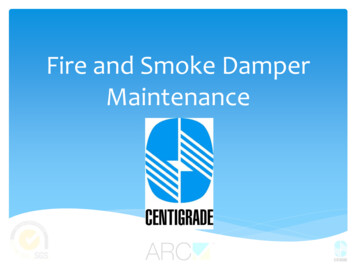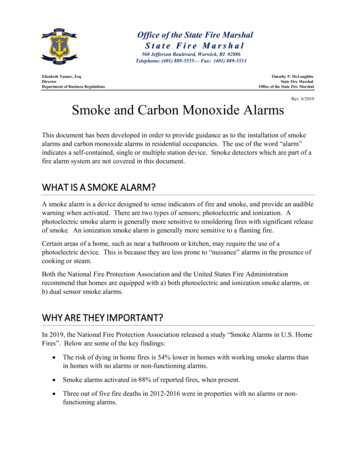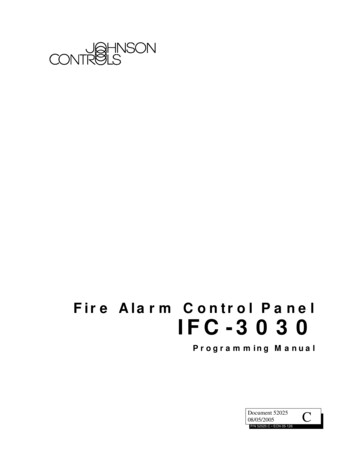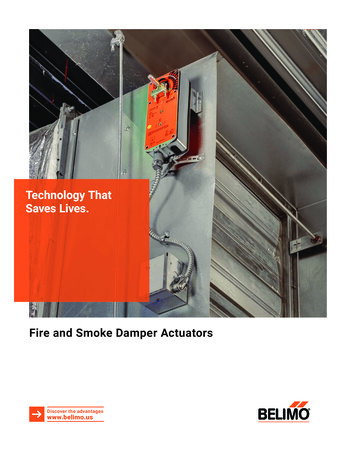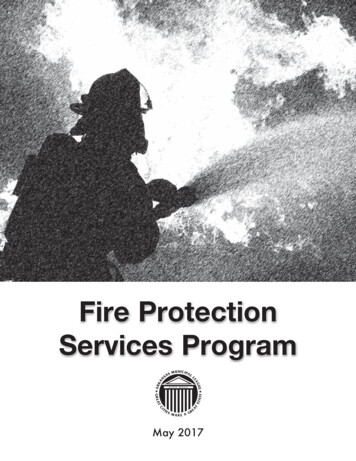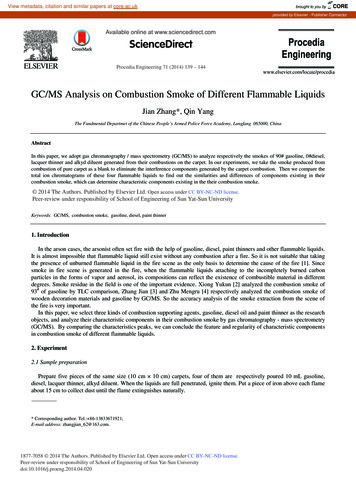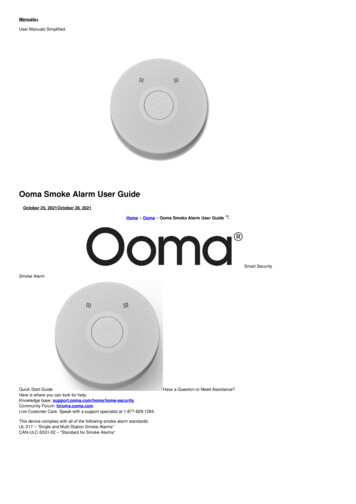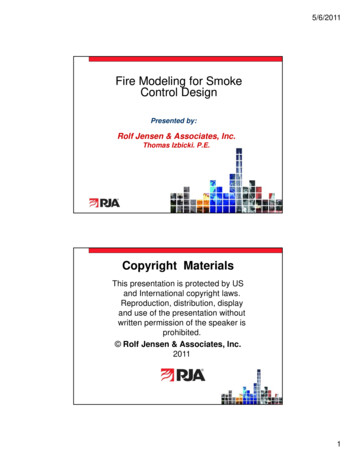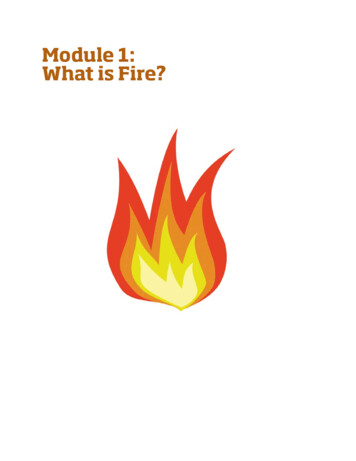
Transcription
Basic Training - Fire & Smoke Damper Actuator ReplacementTYPICAL MECHANICALDETAILS
Belimo AmericasBasic Training - Fire & Smoke Damper Actuator ReplacementIntroduction This document’s intent is to provide a Basic Introduction to Fire & Smoke damper actuator replacement.The document includes commonly seen damper installation methods, challenges and solutions to avariety of typical replacement applications.WARNING!Installer must be trained and experienced with repairof fire and smoke dampers and actuators.For specific details on any application, please contact:Mike Bracero at 203-749-3105 (East Coast)Larry Felker at 775-857-4243 x 5205 (West Coast).For more extensive information go to:www.belimo.us/firesmokeTable of ContentsIntroduction . 2Standards and Codes . . 4Replacement Issues . . 5Combination Fire and Smoke Damper Types and Examples . . 6External Single Spring with Fusible Link . 7Dual Springs with Fusible Link . 7McCabe Link . 9Other Prefco Dampers . 9Negator Spring – Ruskin and Air Balance-American Warming. 10External Spring . 11Typical Installation of Internal Spring Actuators . 12Mounting Methods and Typical Accessories . 13Fire Marshal Notification Form . 192
Belimo AmericasBasic Training - Fire & Smoke Damper Actuator ReplacementWARNING - Note on Alarm Systems or Smoke ControlSystemsIf any wiring to an alarm or smoke control has been touched, the Fire Marshalmay require verification that the system remains functional.In some cases the auxiliary switches of the actuator are used to signal statusto a smoke control system. Function cannot be disturbed.In some cases the auxiliary switches power local indicator lights. These haveonly supervisory function and are not part of the fire alarm system.Verify requirements with Authority Having Jurisdiction (AHJ)– Fire Marshal or Building Official.WARNING!In all cases, installation must comply with any and all local electricaland life safety codes. Operation of the system after installation mustbe performed to verify proper damper cycling. Final checkout requiresverifying correct function.The important points that should be taken from this document are:1. The same actuator can be applied several ways since fusible links, thermalsensors, and external springs can be applied different ways to achieve thesame result.2. Investigation of each damper should be performed to identify the right wayto repair.3. After determination of the repairs necessary, performance testing must beperformed.3
Belimo AmericasBasic Training - Fire & Smoke Damper Actuator ReplacementDefinitionsFire Dampers are rarely actuated in the United States.Most Fire Dampers are gravity dampers or spring loadedand released by a heat activated fusible link.Photo Courtesy PottorffSmoke Dampers do not have a high temperature limit. Olderactuators without internal springs depended on a shaft or externalspring to close the damper whenever the actuator power is removed.Combination Fire & Smoke Dampers combines the smoke sealingcapabilities of a standard smoke damper with the high temperature capability ofa fire damper. Combination Fire & Smoke dampers are tested in accordance toUL555 and UL555S.Photo Courtesy PottorffStandards and Codes . ULIn Underwriters Laboratories Inc , April 2003 publication “Marking & Application Guide, Dampers for FireBarrier and Smoke Applications & Ceiling Dampers” page 6, they state:DAMPER ACTUATORS“ field mounting or substitution of actuators is not covered within the scope of the UL certification of theproduct. However, this does not necessarily preclude replacement of actuators in the field. Like anyappliance, field servicing of these products is not covered under the scope of the UL certification andfactory follow-up service program. As with any part of the damper, it is expected that replacement ofactuators in the field be done in accordance with the damper manufacture’s normal field servicingprogram.”4
Belimo AmericasBasic Training - Fire & Smoke Damper Actuator ReplacementNFPARepair recommendations can be found in NFPA 80 Standard for Fire Doors and Other OpeningProtectives, 2007 Edition and NFPA 105 Standard for the Installation of Smoke Door Assemblies andOther Opening Protectives 2007 EditionFire & smoke dampers are considered to be appliances and fieldreplacement of defective parts is required. NFPA also says “after discoveringa failure repair should be performed as soon as possible.”Local CodesThe administrative section of codes state that all mechanical and electrical systems must be kept inworking order and an individual code section may state that all life safety devices and systems must beoperable. Codes rarely address replacement issues in any detail. Consult the Fire Marshal and/orBuilding Department for local requirements. A permit and inspection could be required if a large numberof actuators are being repaired. Some jurisdictions place a limit on the number of devices to be replacedbefore a permit is required. If wiring to the fire alarm or smoke control system is touched, then the firedepartment must be informed. Some actuator auxiliary switches are used to signal the Fire FightersSmoke Control System or Fire Alarm. If so, and an actuator with aux switches is replaced, the firedepartment should be informed.In all cases, a record should be left on the premises when an actuator (or any other part of a damper) isreplaced. The form on the last page may be used if no official form is available locally.Replacement Issues . Change has obsoleted many combinations of products. Some actuators and dampers are no longermanufactured and no current UL555 listings exist. In lieu of other clearly defined replacement criteria, thefollowing technical rules are recommended practice:1. It is standard procedure for damper manufacturers to obtain UL555S listing with several actuators forthe same damper. Where the actuator being installed is UL555S listed, no further requirements arenecessary provided the temperature, time, torque, voltage, amperage are matched correctly andconformance testing is performed. That is, the correct model must be installed and the assemblytested.2. Damper manufacturers have installation instructions for replacement of actuators on some dampers.These should be obtained and utilized. In the past UL allowed field installation of actuators and it wassufficient to use the instructions. UL no longer oversees field or replacement applications.3. Where older dampers or actuators are involved and are no longer manufactured the following rulesshould apply:5
Belimo AmericasBasic Training - Fire & Smoke Damper Actuator Replacementa. Check damper itself for proper operation. Clean all components insure that shifting of ductsor damage to side seals has not restricted closure, or failure of mechanical parts has notoccurred over time. Do not replace the actuator or any components if the entire assembly isnot functional. The warning below appears in the instruction sheets.WARNING!Before replacing actuator, damper must be inspected anddetermined to be fully functional.b. Temperature – the replacement actuator shall operate at the rating of the original actuator –250 F or 350 F.c.Torque – replacement actuator shall have equal or greater torque than the failed actuator.d. Time – the replacement actuator shall drive open and spring closed at the speed required bycodes or as directed by Fire Marshal. In general, use same or faster time as original.e. Voltage – replacement actuator shall have the same voltage rating as the original.f.Amperage – the replacement actuator(s) shall not draw more amperage than the original(s)and cause the total amperage to rise above that which the electrical circuit breaker isdesigned to carry.g. Testing – actuated damper and associated devices shall be tested for proper operation.See Fire Marshal form on last page.h. Where any structural modification is made, a permit is required.i.Where change from pneumatic to electric is performed, a permit is required. In addition,the damper manufacturer’s instructions, wiring diagrams, and other components (e.g.,elevated 250 F thermal disks for electrical interruption) must be used.j.AHJ should be consulted to obtain local rules which do vary among jurisdictions.Note that smoke dampers do not have high temperature limits, bimetals, or fusible links.Therefore, regardless of spring type, a Belimo with internal spring can be employed afterdisabling the old spring. The following applies to combination fire and smoke dampers.Combination Fire and Smoke Damper Types and Examples .6
Belimo AmericasBasic Training - Fire & Smoke Damper Actuator ReplacementExternal Single Spring with Fusible Link-It may be necessary to disable the old spring and primary sensor, installmodern actuator, and install a modern thermal sensor.Some dampers had a single spring that was tensioned when the actuator was driven open; the actuatorheld the damper open when powered. Pottorff and Accurate used this method on some dampers.Then if the smoke detector or relay cut power to the actuator, the shaft spring drove the damperclosed.If the fusible link melted due to elevated temperature (165 F typically), then the connection betweenthe damper and the actuator was separated. The spring then engaged and closed the damper. Theactuator could not drive the damper back open until the fusible link was manually replaced and theconnection remade.There were several variations of this. One was a flat “negator’ spring that touched the damper bladeitself. Another was a spring wrapped around the jackshaft. Another had a spring built into the crank arm.American Warming / Air Balance and Ruskin had several versions like this. Pottorff used this methodalso. See next section.Dampers that used any of these methods require that the spring be removed or disconnected and thefusible link be removed or bypassed if a new actuator is to be installed. An electrical thermal sensor(thermodisc) must also be installed. An exception exists with Ruskin dampers less than 1 sq.ft.The damper manufacturer’s instructions must be used for the repair since changes to the damper arebeing made. AHJ should be consulted regarding the need for witnessing the testing.A Belimo actuator may be installed after making the proper damper modifications.Dual Springs with Fusible Link-In most cases, simply installing a new actuator repairs thedamper function.Most companies used two springs. One was pretensioned and the fusible link held it ready. If the link melted, thedamper slammed closed. This spring was not a load on theactuator. An external spring (example shown to right) was used toclose the damper when the actuator was not powered. When theactuator drove open, it tensioned this spring.This is similar to a modern damper actuator operation.When replacing the actuator, the second actuator spring must beremoved – NOT THE FUSIBLE LINK SPRING. The new actuatorwould have to operate against its own internal spring and the7
Belimo AmericasBasic Training - Fire & Smoke Damper Actuator Replacementexternal spring – a larger actuator would be required and thatapplication is not UL Listed. A Belimo FS actuator may be installedafter removing the defective actuator and external spring. Anyassembly should be examined to see if a fusible link exists and howthe fusible link is set up. This could be a smoke damper and nohigh limit exists. Different damper companies mounted and appliedthe same actuator in different ways.The warning below is placed in instruction sheets. In addition, do notplace hands between damper blades. Inadvertent release of actuator orsprings can allow injury to occur.WARNING!USE CAUTION!Spring is under high torsion and may cause serious injury! If any externalsprings are present, exercise caution – wear face and hand protection.8
Belimo AmericasBasic Training - Fire & Smoke Damper Actuator ReplacementMcCabe Link See drawing at right.Prefco manufacturing used a special bimetal assembly for theelevated temperature limit. Many dampers can accept a modernBelimo actuator and work perfectly.The spring is tensioned when the actuator drives open the firsttime. For this reason, extra actuator torque is needed. Oncepretensioned, the spring is no longer a load on the actuator. Insteadof using 4 sq.ft. per FSLF, 18” X 18” is the maximum damper size.The FSNF may be used for dampers up to 12 sq.ft.Other Prefco DampersSome models used a special pulley-cable and mount for the motor. There is no damper shaftavailable for either direct or linkage mounting. See 5800 EMB drawings. The Belimo FS Series actuatorscannot be used with these. Call Belimo for information or see Belimo Dashboard for cross referencedata. Each case needs to be examined to determine the correct method for installation.Some parts areavailable and the damper manufacturer needs to be contacted for information on modification to a ULapproved version. In many cases, the whole damper must be replaced.5800 EMBBelimo cannot be used to replace the above motors unless a ½” shaft is present.Modern Prefco dampers use thermal sensors and spring return motors.Replacement is straightforward.9
Belimo AmericasBasic Training - Fire & Smoke Damper Actuator ReplacementNegator Spring – Ruskin and Air Balance-American WarmingSOME NEGATOR SPRING DAMPERS USED THERMALSENSORS, SOME USED FUSIBLE LINKS OR RODS.CHECK APPLICATION BEFORE REPLACING ACTUATORThe black arrow points to the spring. The red arrowpoints to the fusible link.Instructions from Air Balance are available formodification of the damper to modern methods. Athermodisc, new linkages, external shaft to actuatorbracket, and new actuator are required as well asformal testing.If access permits, a new damper may be the besttechnical solution.Instead of a fusible link, a fusible rod is used here.Black arrows point to springs and the red arrow to thefusible rod.These applications require special factory contact forrepair and retrofit of actuators. Some kits exist alreadyand some may need to be put together.Obtain make and model of damper and actuator for replacement information.Careful use of instructions required as well as AHJ approval.Better than leaving the old negator spring and making the actuator do extra work holding it open is toinstall a Belimo BAE165 and an actuator while bypassing the old mechanical parts. Approval from theAHJ must be obtained before making these changes. Replacing the damper itself is recommended whenextensive changes are necessary to bring it up to modern control methods.Call for instructions to submit to AHJ.10
Belimo AmericasBasic Training - Fire & Smoke Damper Actuator ReplacementExternal Spring-In the vast majority of cases, removing the old spring and motor andinstalling a new actuator repairs the damper function.SINGLE SPRING WITH THERMODISC. (Method used by Ruskin for many years.) There was anexternal spring that was tensioned when the actuator drove open. There was no fusible link or shaftspring. This functioned like a modern internal spring actuator. See photograph below.The old motor and spring aredisassembled and removed.Then a Belimo can be directcoupled in the old motor’s place.A thermodisc was used initially and cut power if the temperature rose. Both linkages and directcoupled methods were used and both have passed UL555(S).The external spring and non-spring actuator function identically to a modern actuator with an internalspring.These functioned like a modern internalspring actuator. Check the fusible linkoperation in case some modifications havebeen made and function needs to bereestablished.The linkage and actuator are removed andthe Belimo FS actuator mounts on the shaft.11
Belimo AmericasBasic Training - Fire & Smoke Damper Actuator ReplacementTypical Installation of Internal Spring ActuatorsModern (fire & smoke) damper actuators have internal springs.1.SHAFT SPRING WITH FUSIBLE LINK. Some dampers have the fusible link and shaft springand a spring return actuator. The damper functions as the dual spring method detailed above.The actuator can be replaced without modifying the damper, shaft, spring, or link. This is becausethe shaft spring only functions with the fusible link and is not required to close the damper if power isremoved from the actuator. The actuator’s internal spring accomplishes that function in response to thesmoke detector or smoke relay controlled from the area smoke detectors.2.STANDARD ACTUATOR AND THERMODISC(S) – ACTUATOR SPRING ONLY. The smokedetector or smoke relay or thermodisc cuts power to the actuator and it springs the damper closed. Otherthan basic technical specifications – torque, voltage, current draw, speed, and mounting - actuators areinterchangeable.Dual thermodiscmanual reset sensors.FSLF120 ActuatorJackshaftand arm todamperblade.Photograph courtesy Pottorff Division of PCISummarySmoke dampers had no high temperature limit and are simpler to repair in general.There are three general methods for controlling combination fire and smoke dampers:12
Belimo AmericasBasic Training - Fire & Smoke Damper Actuator Replacement1. Single spring with motors without springs. Damper must be rebuilt with manufacturerassistance and/or instructions. Contact Belimo for more information.2. Two springs – one for the fusible link, one for the actuator. Remove defective motor andspring; mount Belimo.3. Modern method with spring inside actuator. Remove defective and replace.Mounting Methods and Typical Accessories Mounting of replacement actuators is dependent upon individual applications, site requirements, and typeof equipment being replaced. A selection of accessories and mounting kits are available. cal Access.Typical example illustrated below:When needed, use a chase nipple to connect electrical J-box to the Belimo ½” conduit connector.A 4” x 4” box can be used when the auxiliary switch wiring goes into a conduit.Check damper manually for smooth operation before mounting actuator. Good installationincludes mounting the actuator straight and level. Bend the anti-rotation strap at the slots toclear the actuator’s splines and any obstructions. Mount in correct spring return direction.Drive open and closed three times to ensure proper operation.13
Belimo AmericasBasic Training - Fire & Smoke Damper Actuator ReplacementOn occasion, a stable platform may be required to securely mount thenew actuator. For a complete review of available mounting hardware,download the Mechanical Accessories guide from the Belimowebsite.Platform bracketsare available fromsome damperOEM’s.Shaft adaptors available in Mechanical Accessories guide.14
Belimo AmericasBasic Training - Fire & Smoke Damper Actuator ReplacementThe following warnings are in installation sheets. The first is a life safety andcode issue. The second an advisory. The third protective to the service technician.WARNING!Actuator anti-rotation strap may not be screwed to the duct. It must attach toeither the sleeve or to the mounting bracket. The duct must be able to fall awayfrom the damper in case of ceiling collapse in a fire.WARNING!Read Data Sheet provided in box with each actuator for specific wiring details.WARNING!Disconnect and lock out power before starting to disconnect old motor.15
Belimo AmericasBasic Training - Fire & Smoke Damper Actuator ReplacementRuskin Damper with MultiProducts Motor to Belimo FSLF120In order to adapt the old MP motor with its .2” square male shaft end, a female socket was welded ontothe damper shaft. The welded piece must stay on the shaft. A shaft adapter insert and actuator with holddown bracket is available from Ruskin.MP2781 was used on FSD60, FSD36,FSD35, FSD34, SD60, SD36, SD35and SD34. FSD is Fire & SmokeDamper. SD is Smoke Damper.RETROFIT KIT FORCONVERTING A DEFECTIVEMP2781 TO FSLF SERIESACTUATOR.Ruskin part numberFSLF120/MP. This must beordered from local rep orRuskin Manufacturing. 816761-7476Kit contains actuator, shaftadaptor, hold-down, andinstruction sheet.This was a negator spring and fusible linkapplication. As long as the damper is 1 sq.ft.or less, Ruskin allows a FSLF actuator toreplace the old MultiProducts. If the negatorspring is broken, replace the damper.WARNING!There was a model similar to the one above that had a shaft spring and fusiblerod or link. One was made by Ruskin and one by Air Balance.The link disconnected the actuator and the spring drove the damper closed. Theactuator has to work against the external spring as well as its own internal spring.The FSNF should be used for that application to ensure sufficient torque.Contact Belimo or damper manufacturer with model number of damper andactuator to obtain replacement instructions.16
Belimo AmericasBasic Training - Fire & Smoke Damper Actuator ReplacementTypical Wiring Methods Where there is a separate damper spring like the Ruskin example above, wiring will be like this:Approximately 85% of modern dampers are wired with a single thermodisc:Fusible link dampers do not have the 165 F thermodisc.About 15% of dampers are installed with a Fire Fighters Smoke Control System override:In all cases, investigate and determine correct wiring methods. These are typical.17
Belimo AmericasBasic Training - Fire & Smoke Damper Actuator ReplacementExampleTwo old motors can be seen. The procedure for replacement was:1. Disconnect and tag all wiring.2. Remove old linkage, external spring, & motors.3. Check and clean dampers. Exercise open and close manually.4. Damper shafts were available so existing brackets were relocated and used to mountFSNF120 actuators and anti-rotation straps. (FSLF was sufficient for torque; howeverlinkage convenience of FSNF was desired.)5. Thermal sensors were present and tested.6. Wiring was cleaned up and connected.7. Testing to assure operation per check list was performed.WARNING!THIS IS A TRAINING DOCUMENT. IT DOESNOT CONTAIN INSTRUCTIONS REQUIREDFOR REPAIR & REPLACEMENT OF DAMPERS& ACTUATORS.Consult Belimo or damper manufacturer forspecific make and model instructions.18
Belimo AmericasBasic Training - Fire & Smoke Damper Actuator ReplacementFire Marshal Notification Form See NFPA 80 & 105 and UL for maintenance and repair requirements.Retain this portion of check list at premises for Fire Marshal inspection. Consult AHJ for other informationand requirements.Test Checklist (Smoke dampers do not have sensors. Only steps a & b apply.)1. Single Sensor Combination Dampera. Open smoke detector or relay wire or contact to cut power. Damper springs closed.b. Reconnect power. Damper drives open.c.Open thermal sensor using heat gun. Damper springs closed.d. Press thermal sensor manual reset. Damper drives open.Repeat 3 times to ensure operation. This imitates UL555S test.2. Reopenable Two Sensor Fire-Smoke Combination Damper(Since this system involves the Firefighters’ Smoke Control System, inform fire department.)With FSCS switch in Auto position:a. Disconnect power from smoke detector or relay contacts. Actuator springs damper closed.b. Reconnect power. Actuator drives damper open.c.Trip thermal sensor. Actuator springs damper fully closed.d. Press manual reset. Actuator drives damper open.Test FSCS switch functions:a. Move FSCS switch to Off position. Actuator springs damper fully closed.b. Move FSCS switch to Hand position. Actuator drives damper open.c.Trip secondary (higher temperature) thermal sensor. Actuator springs damper fully closed.d. Press manual reset of secondary sensor. Actuator drives damper open.Move FSCS switch back to Auto position:a. Actuator springs damper closed if Primary sensor is still open.b. Actuator stays open if Primary sensor has re-closed.When completed, ensure sensors are reset and smoke detector is in normal state and FSCSswitch is in Auto. Damper is normally Open; check sequence of operation.Damper Numbers or Location Identifying Numbers. Date - -. Contractor .Service Technician (Print) . Service Technician (Signed) . Phone Number ( ) Notes . . . . 19
2. Damper manufacturers have installation instructions for replacement of actuators on some dampers. These should be obtained and utilized. In the past UL allowed field installation of actuators and it was sufficient to use the instructions. UL no longer oversees field or replacement applications. 3.
